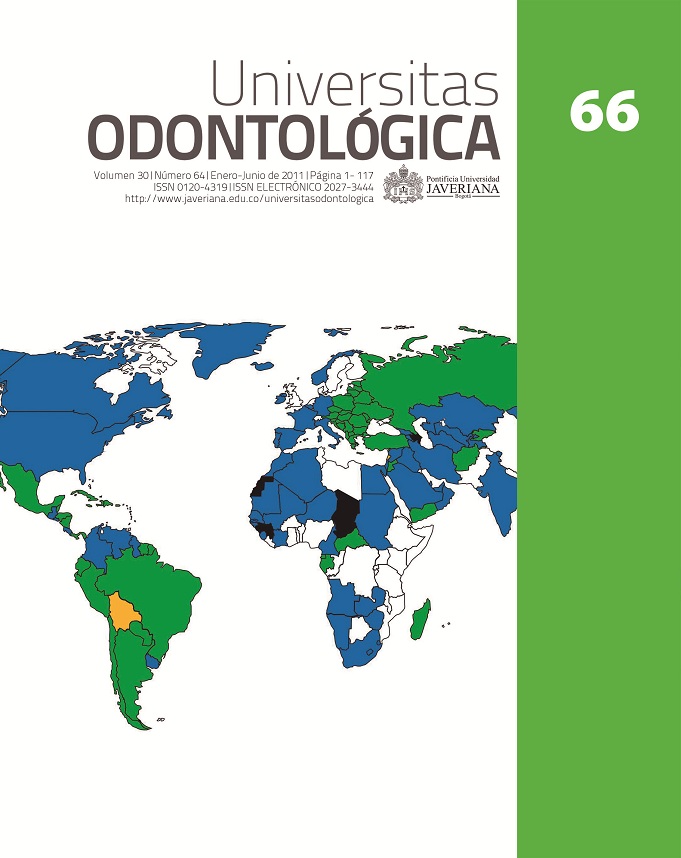Resumo
Antecedentes: la caries en la primera infancia es considerada un problema de salud pública en muchos países. En Colombia, el 60,44 % de los niños a los cinco años tiene historia de caries. En el Jardín Infantil, la Facultad de Odontología realizó intervenciones de promoción de salud bucal en las últimas tres décadas, enmarcadas en programas académicos. Métodos: se realizó un estudio descriptivo transversal. La investigadora aplicó encuestas a los cuidadores y examinó clínicamente a 118 niños de los 150 matriculados. Resultados: el ceo-d de los niños valorados del jardín corresponde a un 0,805 que, según la OMS, está catalogado como muy bajo. En una valoración en el 2005 se encontró un 36,06 % de niños enfermos con caries cavitacionales contra el 14,4 % de niños con presencia de caries activas cavitadas y no cavitadas. Esto demuestra mejores condiciones de salud bucal, si se compara con el 54,4 % de niños que presentan caries a los cinco años en el ámbito nacional y el 59,3 % de niños en las mismas condiciones en Bogotá. En cuanto a educación para la salud, los resultados de las encuestas revelan que el 80 % de los cuidadores de los niños tienen una suficiencia conceptual que les permite brindar cuidados e promover conductas para prevenir enfermedades bucales. Conclusión: en Colombia la caries de infancia temprana requiere un abordaje con programas basados en adquisición de hábitos saludables mediados por educación con énfasis en nutrición e higiene desde antes del nacimiento y con alianzas estratégicas con escuela saludable y empresas promotoras de salud.
Background: Early childhood cavities are considered a public health problem in many countries. In Colombia, 60.44 % children age five have a history of cavities. Since 1980, the Dental School has implemented dental health promotion interventions in the kindergarten. Methods: A descriptive study was carried out. The researcher administered surveys to the caregivers and examined 118 children out of the 150 enrolled. Results: dmf-t Index of the children assessed in the kindergarden was 0.805, which, according to the WHO standards, is considered very low. A study in 2005 showed that 36.06 % children suffered from cavitational caries, compared to 14.4 % children with active cavitated and non-cavitated caries. This shows a better dental health status when compared with 54.4 % five-year-old children with dental cavities nationwide and 59.3 % children under the same conditions in Bogotá. Regarding health education, the surveys show that 80 % caregivers possess conceptual sufficiency to provide dental care and promote disease preventive habits. Conclusion: In Colombia, early childhood caries should be considered a public health problem and it is necessary to emphasize promotion and prevention programs based on the acquisition of healthy habits mediated by education with an emphasis on nutrition and hygiene from birth, in order to implement these strategies in schools.
Este periódico científico está registrado sob a licença Creative Commons Atribuição 4.0 Internacional. Portanto, este trabalho pode ser reproduzido, distribuído e comunicado publicamente em formato digital, desde que os autores e a Pontifícia Universidade Javeriana sejam reconhecidos. Citar, adaptar, transformar, autoarquivar, republicar e criar novas obras a partir do material é permitido para qualquer finalidade (mesmo comercial), desde que a autoria seja devidamente reconhecida, um link para o trabalho original seja fornecido e quaisquer alterações sejam indicadas. A Pontifícia Universidade Javeriana não detém os direitos sobre os trabalhos publicados, e o conteúdo é de exclusiva responsabilidade dos autores, que mantêm seus direitos morais, intelectuais, de privacidade e de publicidade.


